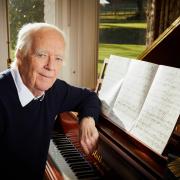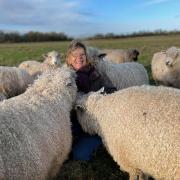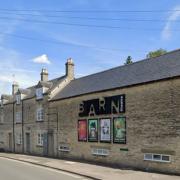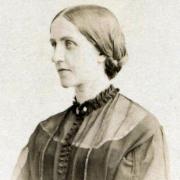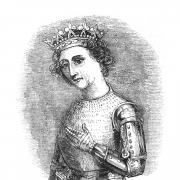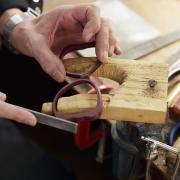Many of us may not be aware of this country’s ‘concrete’ or visual poets, but a new exhibition coming to Nailsworth this month is about to change that
Festival of Words, Nailsworth, July 5-10
There’s a photograph of David Hockney – somewhere; in some archives – idling on the King George V playing fields in Nailsworth. Another of him sketching in a cottage (no electricity; no running water) above the town in Hazel Wood: preliminary sketches to his first real work, he later revealed.
‘I’ve got pictures of him playing skittles in the Brit [the town’s Britannia Inn]. You wouldn’t believe Nailsworth,’ Professor Bernard Moxham muses. ‘Allen Ginsberg; John Cage; Merce Cunningham…. They would all come here.’
Why? Why would these international artists – painter, poet, composer, dancer/choreographer amongst them – be attracted to a small, working (fairly nondescript in Cotswold terms) town in the middle of nowhere?
Enter two rather extraordinary characters.



The first is dom Sylvester Houédard, a Benedictine monk at Prinknash Abbey, Cranham. Houédard, himself an artist, created ‘typestracts’ – abstract forms using the typewriter (until, years down the line, his fellow monks confiscated it, fed up with the noise).
Enter our second character: John Furnival. This was the 60s, and John had recently graduated from the Royal College of Art where he’d rubbed shoulders with the likes of Hockney and the American Ron Kitaj. Now teaching at art schools in Stroud and Cheltenham – living in that rustic cottage in Hazel Wood – he held an exhibition at Gloucester Museum and Art Gallery. The exhibition centred around his idiosyncratic, brilliant works of art where words morph into images to stimulate the viewer: richness, playfulness, beauty, ambiguity. John called it ‘visual poetry’; others use the term concrete poetry.
Houédard walked in to this startling exhibition and was hooked. ‘He arranged to meet John at a bar called the Monk’s Retreat; so into this pub flowed a real monk, much to the amusement of everyone there.’
The two of them gelled artistically and philosophically; so much so that they collaborated on a press called Openings, distributing visual art – concrete poetry – in magazine-form along with postcards and prints.
‘And this was really the start of it all.’

SO, LET’S back- (and forward-) track a little.
Professor Bernard Moxham is something of an expert on his late friend, the artist John Furnival: he’s curated exhibitions and volumes of his work; he wrote his obituary for the Guardian when John died, aged 87, two years ago.
Bernard is not a literary professor. ‘I’m emeritus professor of anatomy at Cardiff… But anatomists are very iconophilic.’
Perhaps even more relevantly, he has an aversion to people being pigeon-holed. ‘Stuffed into silos,’ as he terms it. ‘When I first went to university, everybody was interested in what everybody else was doing.’
Indeed, Bernard realised early on that combining disciplines was a sure-fire way of learning more about your own specialism.
‘One of the things I did with my medical students, who were learning anatomy by dissection, was to say to them, ‘You’re going to write poems and short stories about your experience of dealing with this donation from the person you’re dissecting’. The idea of having to write something horrified them to start with: ‘Oh, no! I can’t do that!’ Most had come through a scientific route.’

Yet it became, for Bernard’s students, an important way of learning to deal with a mortality they’d often never come up against before. A way of turning bones and bodies back into real people. ‘You can teach medical students the words to empathise with someone who is terminally ill; but, unless you understand your own mortality, you can’t really empathise.’
A lifelong appreciator of art in all its forms (in other words), Bernard happened – one day in the 70s – to be in the London studio of Tom Phillips.
‘As I was buying a painting of his, Tom said, ‘Where do you come from?’ and I said Nailsworth. He asked me if I knew John Furnival. I said, ‘Of course I know his work!’ Tom said, ‘But do you know him? He lives in the same place as you.’’
Plucking up courage, Bernard introduced himself to John, who invited him and his wife, Ruth, to dinner.
The two men became like family. John’s widow Astrid – a textile artist who would spin her own wool and produce dyes from plants in her garden – remains a great friend.


WE’RE SITTING – Bernard and I – in Nailsworth’s Three Storeys café, the town’s wonderful creative arts venue, flicking through images of John’s works. John holding Devil Trap that he created, a kinetic sculpture painted with spiralling words: demons become so curious, they pursue those twirling words down, down, down to a trap at the bottom. Following in Nature’s Footsteps is an inked wood panel featuring a maze of words taken from Nature scientific periodicals (Bernard is one of two figures negotiating the maze).
‘John was multi-lingual. In his youth, he worked for the Ministry of War, translating Russian communiqués alongside the young Dennis Potter. John was sure he was one of the characters in Lipstick on Your Collar.’
Another work is a collaboration by John and Astrid – ceramic tiles with the names of plants embedded in them, glazed by the ash of the plant itself.
The descriptions ‘Dadaist’, ‘Joycean’, ‘beauty’, ‘humour’, ‘impolite’ populate Bernard’s commentary.
As do stories.

‘Most of those stories you wouldn’t believe! He knew everybody, did Sylvester. He brought John Cage to Nailsworth to see John [Furnival]. Both of them were fixated on the music of Erik Satie, so they met and had dinner.
‘During this dinner – and I don’t know why it came into the conversation – John Furnival said to John Cage, ‘Do you know that if you press an egg in a certain direction, it won’t break?’ John Cage said, ‘I don’t believe you’. So John Furnival put the egg over John Cage’s head – and, of course, it broke. So there was one of the most famous composers in the world with egg streaming down his face.
‘Then there was Allen Ginsberg chasing John around the table... But that’s another matter.’
When Astrid tired of pushing prams up Wood Lane to that primitive cottage of theirs (where Hockney stayed with them for a while), they moved to Rooksmoor House on the A46. You can still see the wall John built, named the Wall of the World because it contained gems – pieces of the Pyramids; the Great Wall of China – that people collected and gave to him.

ON THE WHOLE, you’ll have more luck catching the work of this country’s concrete and visual poets on the continent. There, critics delight in this medium that links the pleasure of the eye with the disposition of words.
But not so much here.
Too literary for this country’s art critics and curators, Bernard Moxham supposes. Not polite enough.
‘There is,’ he says, ‘something very British about not appreciating this.’

An exhibition of the Cotswold’s concrete/visual poets – John and Astrid Furnival; dom Sylvester Houédard; Kenelm Cox; Thomas A Clarke; Charles Verey - will take place during the Festival of Words at Three Storeys, Old Bristol Rd, Nailsworth GL6 0JE.
For a full festival programme, visit threestoreys.co.uk
For more on John Furnival, go to johnfurnival.com




